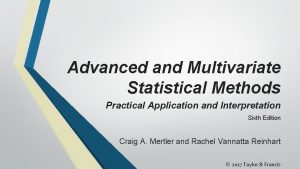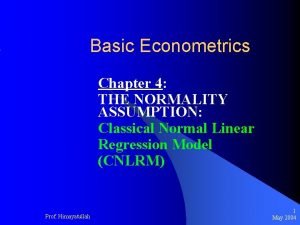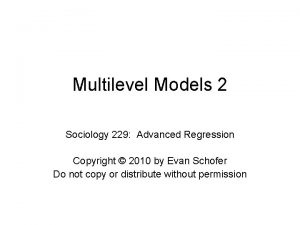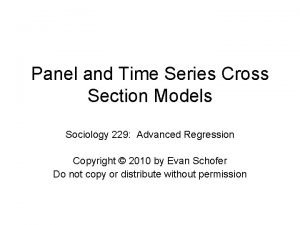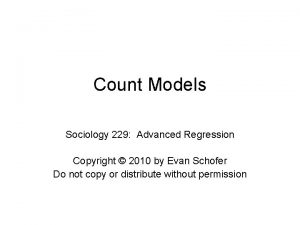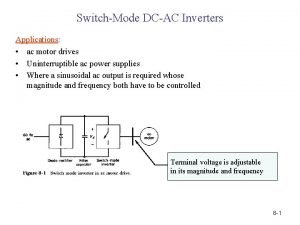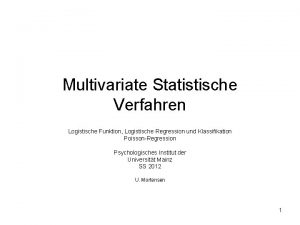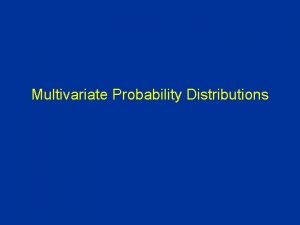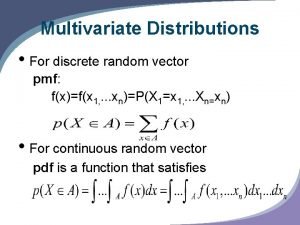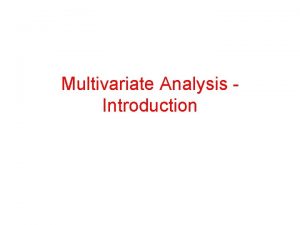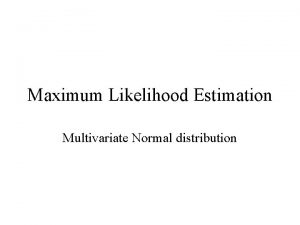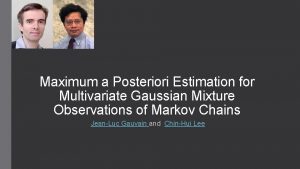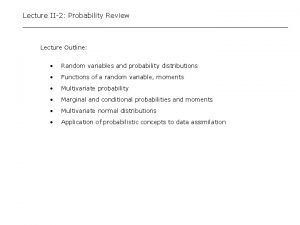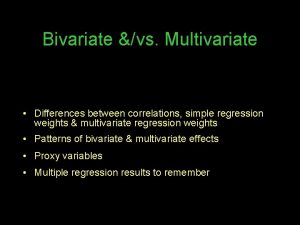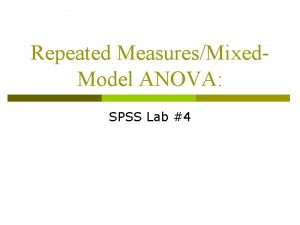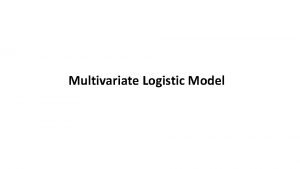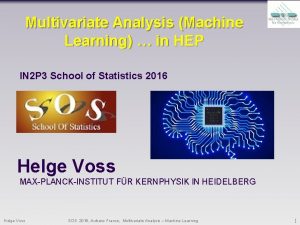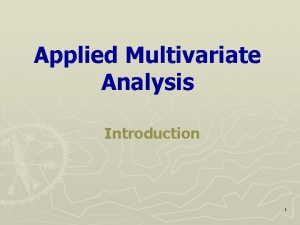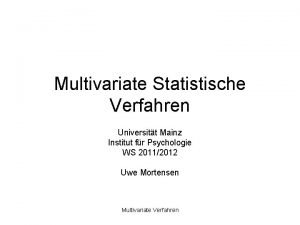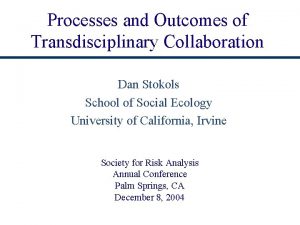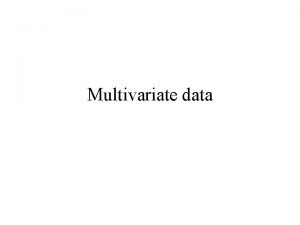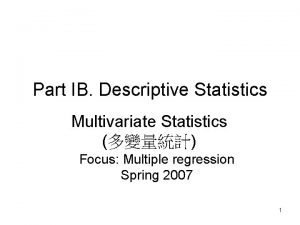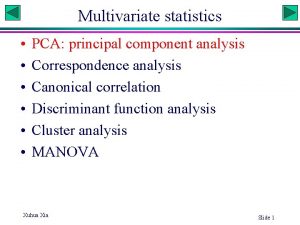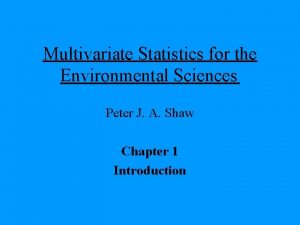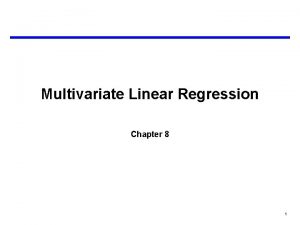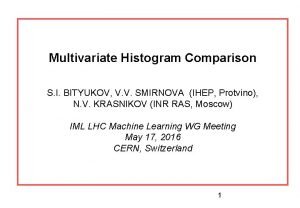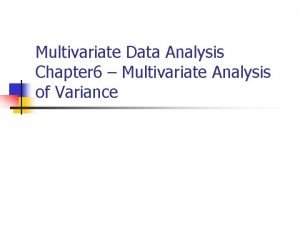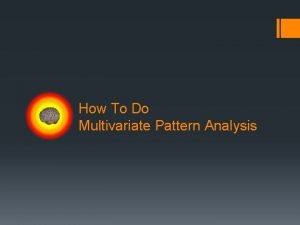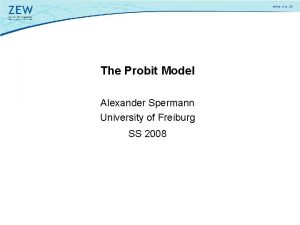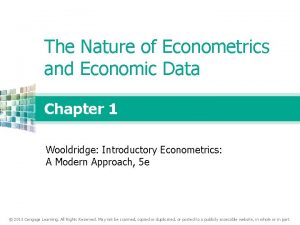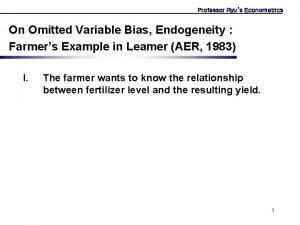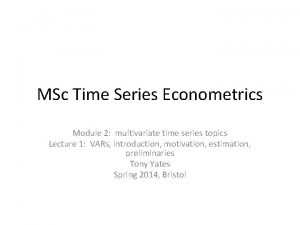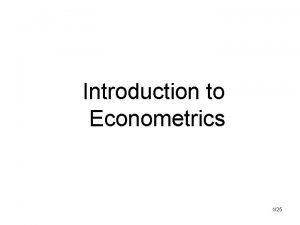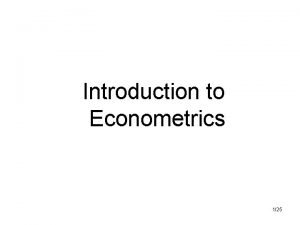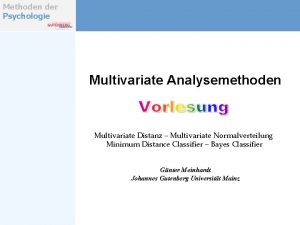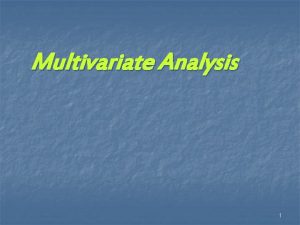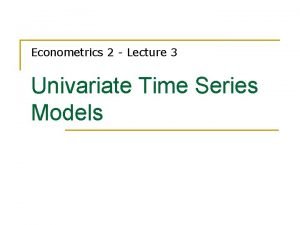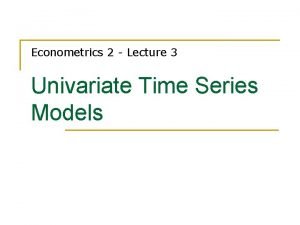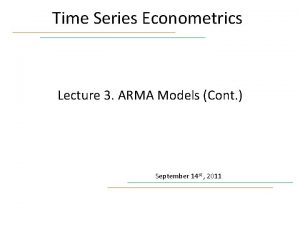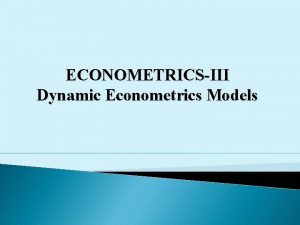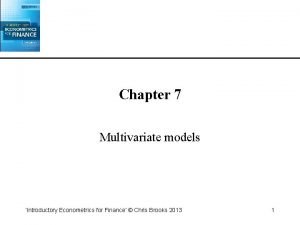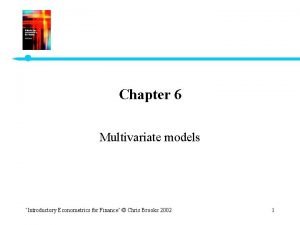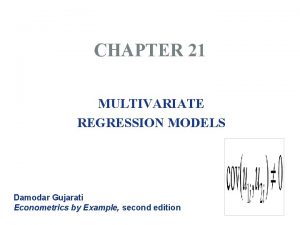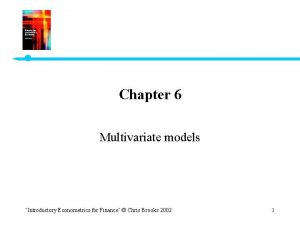Advanced Econometrics Lecture 6 Multivariate Time Series Models

















































- Slides: 49

Advanced Econometrics - Lecture 6 Multivariate Time Series Models

Advanced Econometrics Lecture 6 n n n n Econometric Models Multiplicators and ADL Models Cointegration VAR Models Cointegration and VAR Models Vector Error-Correction Model Estimation of VEC Models April 23, 2010 Hackl, Advanced Econometrics, Lecture 6 2

The Lüdeke Model for Germany Consumption function Ct = α 1 + α 2 Yt + α 3 Ct-1 + ε 1 t Investment function It = β 1 + β 2 Yt + β 3 Pt-1 + ε 2 t Import function Mt = γ 1 + γ 2 Yt + γ 3 Mt-1 + ε 3 t Identity relation Yt = Ct + It - Mt-1 + Gt with C: private consumption, Y: GDP, I: investments, P: profits, M: imports, G: governmental spendings endogenous: C, Y, I, M exogenous: G, P-1 April 23, 2010 Hackl, Advanced Econometrics, Lecture 6 3

Econometric Models Basis is the multiple linear regression model Model extensions n Dynamic models n Systems of regression relations April 23, 2010 Hackl, Advanced Econometrics, Lecture 6 4

Dynamic Models: Examples Demand model: describes the quantity Q demanded of a product as a function of its price P and the income Y of households Demand is determined by n Current price and current income (static model): Qt = β 1 + β 2 Pt + β 3 Yt + εt n Current price and income of the previous period (dynamic model): Qt = β 1 + β 2 Pt + β 3 Yt-1 + εt n Current price and demand of the previous period (dynamic autoregressive model): Qt = β 1 + β 2 Pt + β 3 Qt-1 + εt April 23, 2010 Hackl, Advanced Econometrics, Lecture 6 5

The Dynamic of Processes Static processes: immediate reaction to changes in regressors, the adjustment of the dependent variables to the realizations of the independent variables will be completed within the current period, the process seems to be always in equilibrium Static models are inappropriate n Some processes are determined by the past, e. g. , energy consumption depends on past investments into energy-consuming systems and equipment n Actors in economic processes may respond delayed, e. g. , time for decision-making and procurement processes exceeds the observation period n Expectations: e. g. , consumption depends not only on current income but also on the income expectations; modeling the expectation may be based on past development April 23, 2010 Hackl, Advanced Econometrics, Lecture 6 6

Elements of Dynamic Models n n Lag structures, distributed lags: they describe the delayed effect of one or more regressors on the dependent variable; e. g. , the distributed lag of order s, the DL(s) model, is Yt = δ + Σsi=0 φi. Xt-i + εt Geometric or Koyck lag structure: infinite lag structure with φi = λ 0 λi ADL models: autoregressive model with lag structure, e. g. , the ADL(1, 1) model Yt = δ + θYt-1 + φ0 Xt + φ1 Xt-1 + εt Error correction model: ΔYt = - (1 -θ)(Yt-1 - α - βXt-1) + φ0 ΔXt + εt which is obtained from the ADL(1, 1) model with α = δ/(1 -θ) and β = (φ0+φ1)/(1 - θ) April 23, 2010 Hackl, Advanced Econometrics, Lecture 6 7

Advanced Econometrics Lecture 6 n n n n Econometric Models Multiplicators and ADL Models Cointegration VAR Models Cointegration and VAR Models Vector Error-Correction Model Estimation of VEC Models April 23, 2010 Hackl, Advanced Econometrics, Lecture 6 8

Example: Consumption Function Data for Austria (1976: 1 – 1995: 2), logarithmic differences: Ĉ = 0. 009 + 0. 621 Y with t(Y) = 2. 288, R 2 = 0. 335 DL(2) model, same data: Ĉ = 0. 006 + 0. 504 Y – 0. 026 Y-1 + 0. 274 Y-2 with t(Y) = 3. 79, t(Y-1) = – 0. 18, t(Y-2) = 2. 11, R 2 = 0. 370 Effect of income on consumption: n Short term effect, i. e. effect in the current period: ΔC = 0. 504, given a change in income ΔY = 1 n Overall effect, i. e. , cumulative current and future effects ΔC = 0. 504 – 0. 026 + 0. 274 = 0. 752, given a change in income ΔY = 1 April 23, 2010 Hackl, Advanced Econometrics, Lecture 6 9

Multiplicators Describe the effect of a change in explanatory variable X by ΔX = 1 on current and future values of the dependent variable Y n DL(s) model: Yt = δ + φ0 Xt + φ1 Xt-1 + … + φs. Xt-s + εt q short run or impact multiplier: effect of the change in the same period (ΔY = φ0) q long run or equilibrium multiplier: the effect of ΔX = 1, cumulated over all future (ΔY = φ0 + … + φs) n ADL(1, 1) model: Yt = δ + θYt-1 + φ0 Xt + φ1 Xt-1 + εt q impact multiplier: ΔY = φ0; after one period: ΔY = θφ0 + φ1; after two periods: ΔY = θ(θφ0 + φ1); etc. q equilibrium multiplier: φ0 + (θφ0 + φ1) + θ(θφ0 + φ1) + … = (φ0 + φ1)/(1 – θ) April 23, 2010 Hackl, Advanced Econometrics, Lecture 6 10

Multiplicators, cont’d Describe the effect of a change in explanatory variable X on current and future values of Y n ADL(1, 1) model written as error correction model ΔYt = -(1 -θ)(Yt-1 - α - βXt-1) + φ0 ΔXt + εt effects on ΔY q due to changes ΔX q due to equilibrium error, i. e. , Yt-1 - α - βXt-1, a negative adjustment -(1 -θ)(Yt-1 - α - βXt-1) April 23, 2010 Hackl, Advanced Econometrics, Lecture 6 11

The ADL(p, q) Model ADL(p, q): generalizes the ADL(1, 1) model: θ(L)Yt = δ + Φ(L)Xt + εt with lag polynomials θ(L) = 1 - θ 1 L - … - θp. Lp , Φ(L) = φ0 + φ1 L + … + φq. Lq Given invertibility of θ(L), i. e. , θ 1 + … + θp < 1, Yt = θ(1)-1δ + θ(L)-1Φ(L)Xt + θ(L)-1εt The coefficients of θ(L)-1Φ(L) describe the dynamic effects of X on current and future values of Y n equilibrium multiplier ADL(0, q): coincides with the DL(q) model; θ(L) = 1 April 23, 2010 Hackl, Advanced Econometrics, Lecture 6 12

Partial Adjustment Model Describes the process of adapting to a desired or planned value Example: Stock level K and revenues S n The desired (optimal) stock level K* depends of the revenues S K*t = α + βSt + ηt n Actual stock level Kt deviates from K*t n (Partial) adjustment according to Kt – Kt-1 = (1 - θ)(K*t – Kt-1) with 0 < θ < 1 n Substitution for K*t gives the AR form of the model Kt = Kt-1 + (1 - θ)α + (1 - θ)βSt - (1 - θ)Kt-1 + (1 – θ)ηt = δ + θKt-1 + φ0 St + εt which is a ADL(1, 0) model April 23, 2010 Hackl, Advanced Econometrics, Lecture 6 13

Advanced Econometrics Lecture 6 n n n n Econometric Models Multiplicators and ADL Models Cointegration VAR Models Cointegration and VAR Models Vector Error-Correction Model Estimation of VEC Models April 23, 2010 Hackl, Advanced Econometrics, Lecture 6 14

The Drunk and her Dog M. P. Murray, A drunk and her dog: An illustration of cointegration and error correction. The American Statistician, 48 (1997), 37 -39 drunk: xt – xt-1 = ut dog: yt – yt-1 = wt Cointegration: xt–xt-1 = ut+c(yt-1–xt-1) yt–yt-1 = wt+d(xt-1–yt-1) April 23, 2010 Hackl, Advanced Econometrics, Lecture 6 15

A Macro-Economic Example I(1) variables n M: money stock n P: price level n Y: output n R: nominal interest rate Equilibrium relation (in logarithms) m - p = γ 0 + γ 1 y + γ 2 r, γ 1 > 0; γ 2 < 0 Theory implies that x’β = (m, p, y, r) (1, - γ 2)’ = m - p - γ 1 y - γ 2 r ~ I(0) Deviations from the equilibrium are corrected April 23, 2010 Hackl, Advanced Econometrics, Lecture 6 16

Notation Non-stationary variables X, Y: Xt ~ I(1), Yt ~ I(1) exists β such that Zt = Yt - βXt ~ I(0) n Xt and Yt are cointegrated, have a common trend n β is the cointegration parameter n (1, - β)’ is the cointegration vector Cointegration implies a long-run equilibrium April 23, 2010 Hackl, Advanced Econometrics, Lecture 6 17

Long-run Equilibrium defined by Yt = α + βXt Equilibrium error: zt = Yt - βXt - α = Zt - α n zt ~ I(0): equilibrium error stationary, fluctuating around zero n Yt, βXt not integrated: q zt ~ I(1), non-stationary process q Yt = α + βXt does not describe an equilibrium Cointegration vector implies a long-run equilibrium relation April 23, 2010 Hackl, Advanced Econometrics, Lecture 6 18

Identification of Cointegration Information about cointegration: n Economic theory n Visual inspection of data n Statistical test April 23, 2010 Hackl, Advanced Econometrics, Lecture 6 19

Testing for Cointegration Non-stationary variables Xt ~ I(1), Yt ~ I(1) Yt = α + βXt + εt n Xt and Yt are cointegrated: εt ~ I(0) n Xt and Yt are not cointegrated: εt ~ I(1) Tests for cointegration: n If β is known, unit root test based on differences Yt - βXt n Unit root test based on residuals et Δet = γ 0 + γ 0 et-1 + ut Critical values, Verbeek, Tab. 9. 2 n Cointegrating regression Durbin-Watson (CRDW) test: DW statistic from OLS-fitting Yt = α + βXt + εt Critical values, Verbeek, Tab. 9. 3 April 23, 2010 Hackl, Advanced Econometrics, Lecture 6 20

OLS Estimation To be estimated: Yt = α + βXt + εt cointegrated non-stationary processes Yt ~ I(1), Xt ~ I(1) εt ~ I(0) OLS estimator b for β n Non-standard distribution n Super consistent: q T(b – β) converges to zero q In case of consistency: √T(b – β) converges to zero n Robust n Non-normal; e. g. , t-test misleading n Small samples: bias April 23, 2010 Hackl, Advanced Econometrics, Lecture 6 21

OLS Estimation, cont’d To be estimated: Yt = α + βXt + εt non-stationary processes Yt ~ I(1), Xt ~ I(1) If εt ~ I(1), i. e. , Yt and Xt not cointegrated: spurious regression OLS estimator b for β n Non-standard distribution n High values of R 2, t-statistic n Highly autocorrelated residuals n Low value of DW statistic April 23, 2010 Hackl, Advanced Econometrics, Lecture 6 22

Error-correction Model Granger’s Representation Theorem (Engle & Granger, 1987): If a set of variables is cointegrated then an error-correction relation of the variables exists non-stationary processes Yt ~ I(1), Xt ~ I(1) with cointegrating vector (1, -β)’: error-correction representation θ(L)ΔYt = δ + Φ(L)ΔXt-1 - γ(Yt-1 – βXt-1) + α(L)εt with lag polynomials θ(L) – with θ 0=1 –, Φ(L), and α(L) E. g. , ΔYt = δ + φ1ΔXt-1 - γ(Yt-1 – βXt-1) + εt Error-correction model: describes n the short-run behavior n consistent with the long-run equilibrium Converse statement: if Yt ~ I(1), Xt ~ I(1) have an error-correction representation, they are cointegrated April 23, 2010 Hackl, Advanced Econometrics, Lecture 6 23

Advanced Econometrics Lecture 6 n n n n Econometric Models Multiplicators and ADL Models Cointegration VAR Models Cointegration and VAR Models Vector Error-Correction Model Estimation of VEC Models April 23, 2010 Hackl, Advanced Econometrics, Lecture 6 24

The VAR(p) Model VAR(p) model: generalization of the AR(p) model for k-vectors Yt Yt = δ + Θ 1 Yt-1 + … + Θp. Yt-p + εt with k-vectors Yt, δ, and εt and kxk-matrices Θ 1, …, Θp Shorter: Θ(L)Yt = δ + εt with Θ(L) = I – Θ 1 L - … - Θp. Lp Error terms εt have covariance matrix Σ; allows for contemporary correlation In deviations yt = Yt – μ, with μ = E{Yt} = (I – Θ 1 - … - Θp)-1δ = Θ(1)-1δ Θ(L)yt = εt MA representation: Yt = μ + Θ(1)-1εt = μ + εt + A 1εt-1 + A 2εt-2 + … April 23, 2010 Hackl, Advanced Econometrics, Lecture 6 25

Example: Income and Consumption Model: Yt = δ 1 + θ 11 Yt-1 + θ 12 Ct-1 + ε 1 t Ct = δ 2 + θ 21 Ct-1 + θ 22 Yt-1 + ε 2 t With Z = (Y, C)‘, 2 -vectors δ and ε, and (2 x 2)-matrix Θ, the VAR(1) model is Zt = δ + ΘZt-1 + εt Represents each component of Z as a linear combination of lagged variables April 23, 2010 Hackl, Advanced Econometrics, Lecture 6 26

Income and Consumption, cont’d AWM data base, 1970: 1 -2003: 4: PCR (real private consumption), PYR (real disposable income of households); respective annual growth rates: C, Y Fitting Zt = δ + ΘZt-1 + εt with Z = (Y, C)‘ gives Y C δ Y-1 C-1 adj. R 2 AIC θij 0. 001 0. 825 0. 082 0. 80 -6. 94 t(θij) 0. 91 12. 09 1. 07 Θij 0. 003 0. 061 0. 826 0. 79 -7. 16 t(θij) 2. 36 0. 97 11. 69 with AIC = -14. 45; VAR(2) model: AIC = -14. 43 Compare: consumption function Ĉ = 0. 011 + 0. 718 Y with t(Y) = 15. 55, adj. R 2 = 0. 65, and AIC = 6. 61 April 23, 2010 Hackl, Advanced Econometrics, Lecture 6 27

VAR Models: Advantages Besides the generality of the specification: n Meets assumptions of OLS estimation n Requires no distinction between endogenous and exogenous variables (which is always arbitrary) n Allows for non-stationarity and cointegration The number of parameters to be estimated grows rapidly with p and k Number of components of Θ for some values of p and k April 23, 2010 p 1 2 3 k=2 4 8 12 k=4 16 32 56 Hackl, Advanced Econometrics, Lecture 6 28

Advanced Econometrics Lecture 6 n n n n Econometric Models Multiplicators and ADL Models Cointegration VAR Models Cointegration and VAR Models Vector Error-Correction Model Estimation of VEC Models April 23, 2010 Hackl, Advanced Econometrics, Lecture 6 29

VAR(p) Model, Stationarity and Cointegration VAR(p) process n is stationary, if all roots zi of the characteristic polynomial Θ(L), det Θ(z) = 0, fulfill |zi| > 1; det Θ: determinant of Θ(. ) For kxk-matrices Θ 1, …, Θp: kp roots n is non-stationary, if zi = 1 is a (multiple) root of the characteristic polynomial Θ(L) For non-stationary variables with the same order of integration, cointegrating relationships may exist April 23, 2010 Hackl, Advanced Econometrics, Lecture 6 30

VAR(1) Model and k=2 VAR(1) model for 2 -vector yt: characteristic polynomial Θ(L) for Θ(z) = I – Θz has 2 roots; three cases a) If both roots of det Θ(z) = 0 have value one, then both variables in y integrated, no cointegrating relationship between them b) If exactly one of the two roots has value one, then the variables cointegrated c) If none of the roots has value one, both variables are stationary, no cointegrating relationship April 23, 2010 Hackl, Advanced Econometrics, Lecture 6 31

Example Model for Y and Y: Xt + αYt = u 1 t, u 1 t = ρ1 u 1, t-1 + ε 1 t (A) Xt + βYt = u 2 t, u 2 t = ρ2 u 2, t-1 + ε 2 t (B) with α ≠ b, independent IID(0, si 2)-processes εi, i = 1, 2 Reduced forms for Y and Y: linear combinations of the ui VAR(1) model Xt = (ρ1 – αδ)Xt-1 – αβδYt-1 + v 1 t Yt = δXt-1 + (ρ1 + βδ)Yt-1 + v 2 t with δ = (ρ1 – ρ2)/(α – β) and linear combinations vi of the εi Characteristic polynomial det Θ(z) = 1 – z(ρ1 – ρ2) + z 2ρ1ρ2 = 0 has characteristic roots z 1 = 1/ρ1 and z 2 = 1/ρ2 April 23, 2010 Hackl, Advanced Econometrics, Lecture 6 32

Example, 1. 2. 3. cont’d Let ρ1 = 1, |ρ2| <1, i. e. , u 1 ~ I(1), u 2 ~ I(0), then z 1 = 1, z 2 > 1; the reduced forms imply X ~ I(1) and Y ~ I(1), i. e. , both are nonstationary, equation (B) indicates cointegration of X and Y; see case b) |ρ1| <1, |ρ2| <1; i. e. , u 1 ~ I(0), u 2 ~ I(0), also X ~ I(0) and Y ~ I(0); all are stationary; see case c) Let ρ1 = ρ2 = 1, i. e. , u 1 ~ I(1), u 2 ~ I(1), both are non-stationary, also X and Y are non-stationary, no cointegrating relation between X and Y; see case a) April 23, 2010 Hackl, Advanced Econometrics, Lecture 6 33

VAR(p) Model: Cointegration VAR(1) model for k-vector yt: characteristic polynomial Θ(L) for Θ(z) = I – Θz has k roots n if k-r roots of the characteristic polynomial det Θ(z) = 0 have the value one, then r cointegrating relationships exist between the variables of yt April 23, 2010 Hackl, Advanced Econometrics, Lecture 6 34

Example, cont’d Case ρ1 = 1, |ρ2| <1: differences ΔXt = – αδXt-1 – αβδYt-1 + v 1 t ΔYt = δXt-1 + βδYt-1 + v 2 t In matrix notation with Z = (X, Y)’: going from Zt = ΘZt-1 + δ + εt to differences gives ΔZt = - (I – Θ)Zt-1 + δ + εt = - Θ(1)Zt-1 + δ + εt with April 23, 2010 Hackl, Advanced Econometrics, Lecture 6 35

Advanced Econometrics Lecture 6 n n n n Econometric Models Multiplicators and ADL Models Cointegration VAR Models Cointegration and VAR Models Vector Error-Correction Model Estimation of VEC Models April 23, 2010 Hackl, Advanced Econometrics, Lecture 6 36

Granger‘s Representation Theorem VAR(1) model: yt = Θ 1 yt-1 + δ + εt, in differences with Θ(L) = I - Θ 1 L Δyt = - Θ(1)yt-1 + δ + εt r{Θ(1)}: rank of Θ(1), cointegrating rank 1. If r{Θ(1)} = 0, then Δyt = δ + εt, i. e. , y is a k-dimensional random walk, each component is I(1), no cointegrating relationship 2. If r{Θ(1)} = r < k, there is a (k - r)-fold unit root, (kxr)-matrices γ and β can be found, both of rank r, with Θ(1) = γβ' the r columns of β are the cointegrating vectors of r cointegrating relations (β in standardized form, i. e. , the main diagonal elements of β are ones) 3. If r{Θ(1)} = k, VAR(1) process is stationary, all components of y are I(0) April 23, 2010 Hackl, Advanced Econometrics, Lecture 6 37

Vector Error-Correction Model VAR(1) model Δyt = - Θ(1)yt-1 + δ + εt Θ(1) = γβ' with r{Θ(1)} = r < k n Δyt is stationary n β'yt is stationary, each of the r columns of β defines a cointegrating relation yt consists of k-r independent deterministic and r independent stochastic trends Vector error-correction model, VEC model (VECM) Δyt = - γβ'yt-1 + δ + εt n Cointegrating rank r n γ: Adaptation parameters April 23, 2010 Hackl, Advanced Econometrics, Lecture 6 38

Example, cont’d Case ρ1 = 1, |ρ2| <1: Standardized form: π = (1, β)’ Cointegrating relation: π’yt-1 = Xt-1 + βYt-1 April 23, 2010 Hackl, Advanced Econometrics, Lecture 6 39

The VEC(1) Model VAR(1) model yt = Θ 1 yt-1 + δ + εt in form of the VEC model Δyt = - γβ'yt-1 + δ + εt with cointegrating rank r describes changes Δyt as function of n the intercept vector δ n of r equilibrium relations Deviations from equilibrium in period t -1 are partly corrected in period t by - γβ'yt-1 adaptation parameters (elements of matrix γ) indicate the proportion of the correction, are a measure of the correction speed April 23, 2010 Hackl, Advanced Econometrics, Lecture 6 40

The VEC(p) Model Extension of the VAR(1) process for the k-vector yt to Θ(L) yt = δ + εt with Θ(L) = I – Θ 1 L - … - Θp. Lp For r{Θ(1)} = r < k Θ(L) = – Θ(1) L + (1 – L)Γ(L) with Θ(1) = γβ' the VAR(p) model can be written as Δyt = - Γ 1Δyt-1 - … - ΓpΔyt-p - γβ'yt-1 + δ + εt Columns of β are cointegrating vectors, define r cointegrating relations Example: VAR(2) process yt = Θ 1 yt-1 + Θ 2 yt-2 + δ + εt results in Δyt = Γ 1Δyt-1 + Πyt-1 + δ + εt with Γ 1 = (-Θ 2), Π = - (I - Θ 1 - Θ 2) = - Θ(1) April 23, 2010 Hackl, Advanced Econometrics, Lecture 6 41

Advanced Econometrics Lecture 6 n n n n Econometric Models Multiplicators and ADL Models Cointegration VAR Models Cointegration and VAR Models Vector Error-Correction Model Estimation of VEC Models April 23, 2010 Hackl, Advanced Econometrics, Lecture 6 42

Estimation of VEC Models Assumption: k-vector yt ~ I(1) Estimation of the parameters: 1. Specification of intercepts and deterministic trends q in the components of yt and q in the cointegrating relations 2. Choice of the cointegrating rank r, R 3 -method of Johansen 3. Estimation of the cointegrating relations, standardizing 4. Estimation of the VEC model April 23, 2010 Hackl, Advanced Econometrics, Lecture 6 43

Johansen‘s R 3 Methode Reduced rank regression or R 3 method, also Johansen's test: an iterative method for specifying the cointegrating rank r The test is based on the k eigenvalues λi (λ 1> λ 2>…> λk) of Y 1‘Y 1 – Y 1ΔY(ΔY‘ΔY)-1ΔY‘Y 1, with ΔY: (Txk) matrix of differences Δyt, Y 1: (Txk) matrix of yt-1 q if r{Θ(1)} = r, the k-r smallest eigenvalues obey: log(1 - λi) = 0 Iterative test procedures n Trace test n Maximum eigenvalue test or max test April 23, 2010 Hackl, Advanced Econometrics, Lecture 6 44

Tests LR tests, based on the assumption of normally distributed errors n Trace test: for r 0 = 0, 1, …, test of H 0: r ≤ r 0 against H 1: r > r 0 λtrace(r 0) = - T Σkj=r 0+1 log(1 - Îj) Îj: estimator of λj Stops when H 0 is rejected for the first time Critical values from simulations n Max test: tests for r 0 = 0, 1, …: H 0: r = r 0 against H 1: r = r 0+1 λmax(r 0) = - T log(1 - Îr 0+1) Stops when H 0 is rejected for the first time Critical values from simulations April 23, 2010 Hackl, Advanced Econometrics, Lecture 6 45

Example: Income and Consumption Model: Yt = δ 1 + θ 11 Yt-1 + θ 12 Ct-1 + ε 1 t Ct = δ 2 + θ 21 Ct-1 + θ 22 Yt-1 + ε 2 t With Z = (Y, C)‘, 2 -vectors δ and ε, and (2 x 2)-matrix Θ, the VAR(1) model is Zt = δ + ΘZt-1 + εt Represents each component of y as a linear combination of lagged variables April 23, 2010 Hackl, Advanced Econometrics, Lecture 6 46

Income and Consumption, cont’d AWM data base: PCR (real private consumption), PYR (real disposable income of households); logarithms: C, Y 1. Check whether C and Y are non-stationary: C ~ I(1), Y ~ I(1) 2. Johansen test for cointegration: given that C and Y have no trends and the cointegrating relationship has an intercept: r = 1 (p <0. 05) the cointegrating relationship is C = 8. 55 – 1. 61 Y with t(Y) = 18. 2 April 23, 2010 Hackl, Advanced Econometrics, Lecture 6 47

Income and Consumption, 3. cont’d VEC(1) model (same specification as in 2. ) Dyt = - γ(β'yt-1 + δ) + ΓDyt-1 + εt DY DC coint Y-1 C-1 adj. R 2 AIC γij 0. 029 0. 167 0. 059 0. 14 -7. 42 t(γij) 5. 02 1. 59 0. 49 Γij 0. 047 0. 226 -0. 148 0. 18 -7. 59 t(γij) 2. 36 2. 34 1. 35 The model explains growth rates of PCR and PYR; AIC = -15. 41 is smaller than that of the VAR(1)-Modell (AIC = -14. 45) April 23, 2010 Hackl, Advanced Econometrics, Lecture 6 48

Exercise Answer questions a. to f. of Exercise 9. 3 of Verbeek April 16, 2010 Hackl, Advanced Econometrics, Lecture 5 49
 Advanced and multivariate statistical methods
Advanced and multivariate statistical methods Gujarati basic econometrics lecture notes ppt
Gujarati basic econometrics lecture notes ppt 01:640:244 lecture notes - lecture 15: plat, idah, farad
01:640:244 lecture notes - lecture 15: plat, idah, farad Advanced inorganic chemistry lecture notes
Advanced inorganic chemistry lecture notes Advanced regression and multilevel models
Advanced regression and multilevel models Advanced regression models
Advanced regression models Advanced regression models
Advanced regression models Geology lecture series
Geology lecture series Dcac lecture series
Dcac lecture series Difference between models and semi modals
Difference between models and semi modals Belkin advanced series surge protector
Belkin advanced series surge protector Logistische funktion
Logistische funktion Multivariate binomial distribution
Multivariate binomial distribution Multivariate pdf
Multivariate pdf Multivariate analysis
Multivariate analysis Linear regression spss
Linear regression spss Maximum likelihood
Maximum likelihood Maximum a posteriori estimation for multivariate gaussian
Maximum a posteriori estimation for multivariate gaussian Multivariate pdf
Multivariate pdf Bivariate vs multivariate
Bivariate vs multivariate Multivariate analysis of variance
Multivariate analysis of variance Multivariate anova spss
Multivariate anova spss Normal equation logistic regression
Normal equation logistic regression Multivariate methods in machine learning
Multivariate methods in machine learning Nature of multivariate analysis
Nature of multivariate analysis Multivariate verfahren psychologie
Multivariate verfahren psychologie Multivariate analysis of variance and covariance
Multivariate analysis of variance and covariance Univariate vs multivariate
Univariate vs multivariate Multivariate scatter plot
Multivariate scatter plot Multivariate descriptive statistics
Multivariate descriptive statistics Multivariate analysis
Multivariate analysis Multivariate statistics for the environmental sciences
Multivariate statistics for the environmental sciences Multivariate statistical analysis
Multivariate statistical analysis Multivariate analysis
Multivariate analysis Multivariate histogram
Multivariate histogram Multivariate analysis
Multivariate analysis Multivariate pattern analysis
Multivariate pattern analysis Ibm p series vs i series
Ibm p series vs i series Elapsed time
Elapsed time Maclaurin series vs taylor series
Maclaurin series vs taylor series Balmer series lyman series
Balmer series lyman series Taylor series of composite functions
Taylor series of composite functions Taylor vs maclaurin
Taylor vs maclaurin General feedback structure
General feedback structure Series aiding and series opposing
Series aiding and series opposing Arithmetic sequence sum formula
Arithmetic sequence sum formula Probit model
Probit model Introductory econometrics
Introductory econometrics Confidence interval econometrics
Confidence interval econometrics Endogeneity econometrics
Endogeneity econometrics
